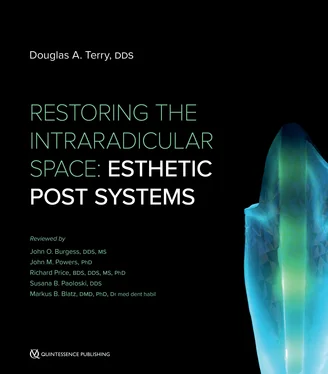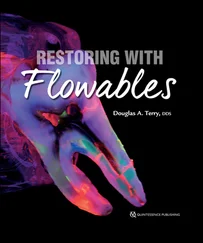In addition, another alternative is the “monoblock concept” that suggests that combining the resin cement as a 2-in-1 material to cement the post and to develop the core buildup allows for an uninterrupted bonding at the dentin-post-core interface (if there is shrinkage, the bond becomes discontinuous.).479 ,529 This combined system allows the transmission of stress between the post and the root structure, improves the force distribution in the root (thus reducing stress concentration at the composite-adhesive interface), 36 , 56and improves the fracture resistance of structurally weakened roots. 41 ,418 ,419 Also, the uninterrupted bonded interface between the dentin, post, core, and crown has the potential to produce a restorative complex that has long-term survival and high strength,479 ,530 while enhancing the clinical performance of the extracoronal restoration.479 ,515 ,516
Therefore, whichever method and material used to achieve the buildup, an optimal adhesion of these interfaces is paramount for a successful tooth-restorative complex.
Extracoronal restoration
The final component is the extracoronal restoration. There are numerous factors to consider for determining the type of restoration required for post-restored ETT, including the amount of remaining tooth structure, occlusal stress on the restored tooth, function and the tooth type,531 amount of reduction for the preparation, and esthetics. Although we are discussing restoring post-restored ETT, it should be noted that endodontically treated anterior teeth with a minimal endodontic access opening or previously minimally restored teeth do not require complete coverage with a crown. However, the exception for these anterior teeth is when they require significant changes in form and/or color that cannot be restored with conservative restorative procedures; then, an extracoronal restoration such as a veneer or full-coverage crown is required.300 For endodontically treated anterior teeth that have significant loss of tooth structure and require a fiber-reinforced post and core, a full-coverage crown is required, whereas all endodontically treated posterior teeth should receive cuspal coverage.531 This recommendation comes from studies that purport that endodontically treated molars have significantly more cuspal deflection than intact teeth,315 and this can result in coronal fractures531 ,532; therefore, cuspal coverage is required. An epidemiologic study of endodontic treatment outcomes indicated that failure rates were lower in all types of teeth that received crowns than in those that did not receive crowns.300 ,533 Furthermore, it has been reported that the presence of two proximal contacts had a significant influence on the survival rates of ETT.159 ,213 ,534 The presence of proximal contacts protects the tooth by distributing the occlusal stresses535 and reduces movement of the tooth. Numerous studies have demonstrated that ETT benefit from the placement of crowns.534 ,536 However, an exception for posterior teeth can be previously restored ETT with only a conservative access opening and with minimal wear. In addition, the mandibular first premolar often presents with an underdeveloped lingual cusp. This cusp may not be subjected to the opposing interocclusal forces that could cause cuspal deflection and induce fracture; thus, a conservative composite restoration may be adequate in this situation.531 ,537 ,538
There are various types of restorations for cuspal coverage, including full-coverage crowns, onlays, and endocrowns. These restorations can be fabricated from a variety of ceramic materials, including feldspathic leucite-based lithium disilicate, fluoroapatite-based high-strength zirconia, and esthetic zirconia using various methods of fabrication.196 Also, it is the author’s opinion that these restorations can be fabricated with laboratory-processed composite using various methods of fabrication for individual clinical situations.196 When the full-coverage crown is utilized, the circumferential ceramic or metal collar provides a protective mechanism for fracture by reducing stresses within the tooth (the so-called “ferrule effect”). Thus, the crown placement of a 2-mm circumferential coronal tooth collar on sound tooth structure provides mechanical resistance for the endodontically restored tooth complex. 70 ,189 ,218 ,281 ,401 ,402 Moreover, an optimal adhesive integration of the extracoronal restoration at this margin on the ferrule preparation reduces the potential for microleakage.212 Consequently, preventing oral fluids from reaching the interfaces of the components of the system can reduce the potential for bacterial infiltration and degradation of the hybrid layer of these adhesive interfaces, reduce secondary caries, and protect the integrity of the endodontic seal. Thus, this final component of the system provides extracoronal integration and can increase the longevity of the endodontically restored tooth.479 ,539
Box 1-2outlines the design principles for the adhesive post-related system.
Box 1-2 Design principles for the adhesive post-retained system
• Maximum post retention and core stability 51 , 105 ,164 ,166 ,168 ,177 ,193 ,216 –218
• Inherent antirotation of the post and core complex by accentuating the eccentric coronal shape of the root canal 105 , 109 ,218
• Minimal removal of tooth structure 105 ,168 ,193 ,218
• Morphologic intraradicular adaptation 105 ,168 ,218
• Optimal esthetics 105 ,218
• Inherent resistance to catastrophic root failure 105 ,193 ,218
• Lack of corrosiveness 105 , 109 ,167 ,218 ,393
• Modulus of elasticity of the post similar to that of root dentin to distribute applied forces evenly along the length of the post 10 , 105 ,218 ,358 ,407 ,408
• Restorative materials with flexural and tensile strength similar to root structure 105 ,218 ,487
• A system with uninterrupted bonding at all interfaces, resulting in increased resistance to fatigue and fracture, enhanced retention, and reduced microleakage and bacterial infiltration 55 , 105 ,218
DEVELOPING A FERRULE EFFECT
The concept of “ferrule” or “ferrule effect” 81 ,540 is considered the most essential element for the reinforcement of the endodontically treated tooth. The term originates from the Latin roots “ferrum” meaning iron and “viriola” meaning bracelet. Thus, the ferrule is an encompassing band of cast metal or ring that embraces the coronal surface of the tooth. 19 , 40 , 42 , 69 , 81 ,301 ,327 ,359 ,377 ,400 ,404 ,541 –545
A modified interpretation is that parallel walls of dentin extending coronally from the crown margin provide a “ferrule preparation design,” which after being surrounded by a crown provides a protective mechanism for fracture by reducing stresses within the tooth called the “ferrule effect.”301 ,377 Others indicate the ferrule design incorporates a crown with a 360-degree collar that encompasses the perimeter of the prepared parallel dentin walls and extends cervically to the prepared tooth margin. This design improves the mechanical resistance of the treated tooth by distributing forces on the remaining tooth structure.405 ,541 ,546 ,547 Preserving tooth structure during preparation is paramount in preventing stress concentrations at the cementoenamel junction of the endodontically restored tooth and providing resistance to tooth fracture. Because maximum preservation of coronal and radicular tooth structure is the primary goal for optimizing biomechanical behavior of the restored tooth 29 , 100 ,301 and the long-term survival of endodontically treated crowned teeth, 14 ,365 the completed crown preparation should have a ferrule design that encapsulates the endodontically restored tooth complex ( Fig 1-16). The objective of the ferrule is to enhance the structural integrity of the endodontically treated tooth by counteracting stresses such as the functional lever forces, the wedging effect of tapered post systems, and the lateral forces generated during post placement. 81 ,180 ,400 ,541 ,548 –550 Factors to consider for the effectiveness of the ferrule include the following design parameters: number of walls, ferrule width, ferrule height and configuration, design of the cervical collar, type of tooth, location in the oral cavity (ie, maxillary/mandibular; anterior/posterior), occlusal forces, remaining wall parallelism, post design and material, core material and type, thickness of cement, and type of restoration. 69 , 80 , 81 , 101 ,153 ,204 ,205 ,301 ,357 ,377 ,400 ,405 ,419 ,541 ,546 ,547 ,551 –558
Читать дальше












